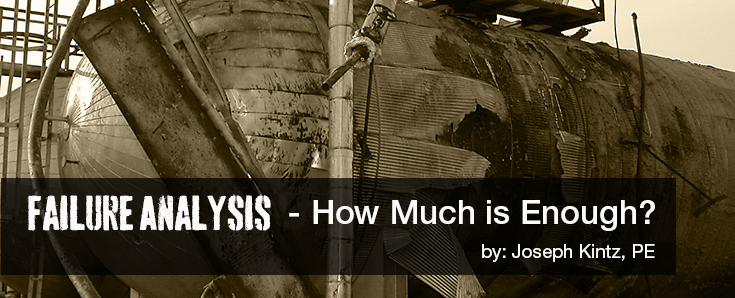Failure Analysis – How Much is Enough?

The year was 1977. I was listening to my engineering professor talk about the failure analysis work he did. He seemed like a detective—uncovering clues, examining evidence, and putting it all together into a story about what happened. Why did the shaft fracture? Why did the pipe corrode? Where did this fragment of metal come from? Was it the manufacturer’s fault that someone threw a come-along winch over a beam and hit someone in the head? I was hooked. This was the kind of engineering I wanted to do.
That was 40 years ago. Since then, I’ve performed thousands of failure analysis investigations on everything from jet engines to wheelbarrow wheels, electrosurgical scalpels to reformers, and engines to pressure vessels.
One thing my professor said back then still resonates in my mind. Whenever approached about a new project, he would ask the client the same question: “Do you want the $50 answer, the $500 answer, or the $5000 answer?” While 40 years of inflation have changed these relative costs, the principle is still valid. Every project does not need $50,000 worth of work. Sometimes the $5000 answer is all the client needs.
When I previously worked for a chemical company, I didn’t have a laboratory ─ just a magnifying glass, flashlight, stereomicroscope, camera, books, and my wits. There were laboratories nearby that I sometimes used but, more often than not, the story I could formulate without laboratory work was all that was needed.
In one case, a pipe cracked and leaked in service. The pipe was cantilevered, and cracked at the toe of a weld. The fracture was straight, flat, and without much plastic deformation. The pipe had been located near a reciprocating compressor, which was known to produce vibration. After an hour of visual examination, and listening to my customer, it was clear that this failure was a fatigue fracture caused by vibration. Of course the pipe could have been defective, but that was unlikely. Also, the weld probably had high levels of residual stress which could have contributed to the fracture, but most welds have residual stress and don’t fracture unexpectedly.
I could have performed a complete metallurgical failure analysis. This would have cost thousands of dollars and taken weeks to complete, and it probably would have verified that the pipe and weld were acceptable. Stress and vibration analysis might also have predicted the fracture. I could have thoroughly documented the failure with photographs, microstructural analysis, chemical analysis, dimensional measurements, electron microscopy, hardness testing, residual stress measurements, and perhaps even finite element analysis. These detailed analyses might have been interesting, but that level of effort was simply unnecessary. The reliability and timeliness of the “one-hour answer” was all my customer needed to repair the damage and prevent recurrence.
By contrast, forensic investigations are often at the other end of the failure analysis spectrum. Someone has been hurt or killed, a plant has been shut down, or property damage has occurred. Someone is at fault. Attorneys will try to convince jurors that the failure was caused by “the other guy.” Each attorney enlists an expert to investigate the failure and provide technical information they need to argue their case. Often “no stone is left unturned” in a forensic failure analysis. If the analyst decides to forgo a test because the answer is obvious (or irrelevant), he or she has opened the door for the opposing attorney to question their conclusions.
One of the most important tasks of failure analysis is to assess the level of effort required. If the answer is needed fast, a seasoned analyst can quickly learn a great deal with their eyes, their ears, and their experience. If more time and money are available, and a more thorough analysis is warranted, a comprehensive laboratory failure analysis should be conducted. If the failure is unusual or difficult to diagnose, or if litigation is anticipated, more in-depth laboratory work or analysis should be performed. In other words, a successful failure analysis can be accomplished by simply tailoring the scope, cost, and duration of the analysis to align with the customer’s needs and desires.
If you would like more information on Failure Analysis, complete a Contact Us form or call us at 281.955.2900.

Joe Kintz, PE – Staff Consultant, Houston Office
Joe has over 37 years of experience performing thousands of materials engineering, metallurgy, failure analysis, material selection, corrosion control, accident investigation, inspection, welding engineering, and litigation support projects for the chemicals, power generation, oil & gas, paper, aerospace, automotive, consumer products, and medical equipment industries.




Leave a Comment
You must Register or Login to post a comment.